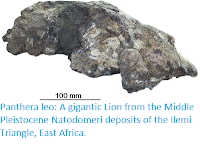Carnivorans play a major role in most Mammalian faunas, modifying the behaviour of almost all other Mammal species, and providing a major source of selective pressure. The faunas of Miocene Africa were dominated by Mammals, but only six Miocene African fossil sites preserve fossil Carnivorans, the Sahabi deposits of Libya, the Nawata and Lothagam formations of Kenya, the Middle-Awash deposits of Ethiopia, the Langebaanweg cave fauna of South Africa and the Toros Menalla Site in the Djourab Desert of Chad. The Toros Menalla Site is most noted for the hominid Sahelanthropus tchadensis, but has also produced a wide range of other Mammal fossils, including a range of Carnivorans that includes Mustelids (Weasels etc.), Canids (Dogs), Herpestid (Mongooses), Viverrids (Civets), Hyaenids (Hyenas) and Felids (Cats).
In a paper published in the journal Geodiversitas on 15 February 2018, Louis de Bonis of the Université de Poitiers, Stéphane Peigné of the Département Origines et Évolution at the Muséum national d’Histoire naturelle, Hassane Taisso Mackaye and Andossa Likius of the Département de paléontologie at the Université de N’Djamena, and Patrick Vignaud and Michel Brunet also of the Université de Poitiers, describe a new species of Sabre-toothed Cat, Machairodontinae, from the Miocene Toros Menalla Site in Chad.
The new species is named Tchadailurus adei, where 'Tchadailurus' means 'Chad Cat' in Greek and 'adei' is 'small' in Goran (a local language). The species is described from a single disarticulated partial skeleton, comprising some isolated teeth and jaw elements, fragments of other parts of the jaws and skull, some isolated vertebrae and ribs, and portions of all four limbs. It is smaller than other Sabre-toothed Cats known from the site, about the size of a modern Lynx, and has a distinctive double-keeled canine tooth.
Tchadailurus adei, from Toros Menalla. Left maxilla with C-M1 in labial (A1), lingual (A2), and occlusal (A3) views; right hemimandible with c-m1 in lingual (B1), labial (B2), and occlusal (B3) views; fragmentary atlas in dorsal (D1) and ventral (D2) views. Scale bar is 10 mm. De Bonis et al. (2018).
See also...
Follow Sciency Thoughts on Facebook.







